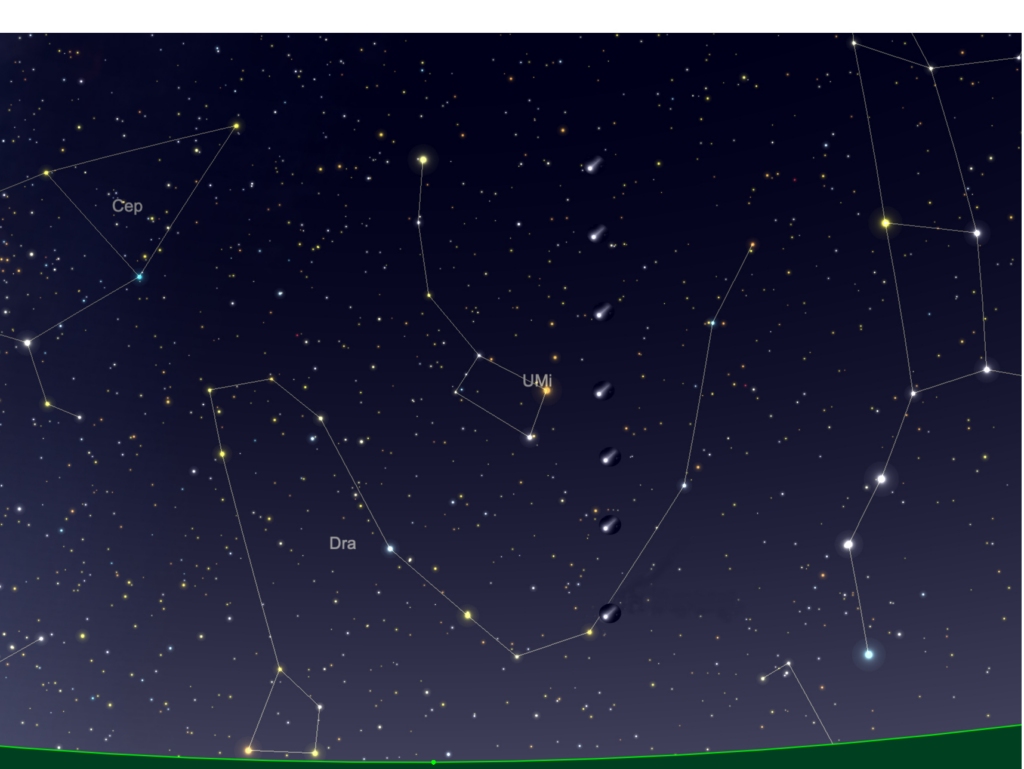Sky Report: January 23 – 29

The comet at about 9:00 p.m., facing north from the 23rd (bottom) to 29th (top). The horizon is green. Graphic created with
SkySafariAstronomy.com.
“Green” Comet C/2022 E3 continues to lead the astronomy news, and this is a good week to look for it before the moon becomes too bright around the 27th and remains bright for about 10 days. The good news is that the comet just moved from the morning sky to the evening sky and you no longer have to get up at 5 a.m. to see it. This week it moves from Draco through Ursa Minor (the Little Dipper) and into the giant but obscure constellation Camelopardalis; from a long dragon to a little bear to a giant camel. Or more simply, it moves upward night by night between the North Star and the Big Dipper.
Early this week you need to wait until the comet has risen high enough to see it, which changes nightly as it moves rapidly northward. On the 23rd wait until at least 10 p.m.; by the 29th you can see it as soon as the sky is fully dark. It should be easily visible in binoculars and any telescope, and to your naked eye if your sky is especially dark and if you know precisely where to look. It’s large and diffuse and it’s low contrast, so the sky needs to be dark to see it at all. Don’t expect to see its tail. Google “comet c/2022 finder chart” and be prepared to learn how to use what it finds; far better is to purchase an inexpensive planetarium software app, learn to use it, and then – like your binoculars – it will always be available.
By the way, someone called it a “green comet” and the media picked up on that with typical *total* lack of understanding. It has a greenish hue on long time exposures due to ionized carbon, but your eye sees it in b/w. Google “why comet green” for details. And it’s not rare.
By now the comet has passed the sun and next week it passes the earth, and it’ll begin to fade. Once the moon is out of the way again you should no longer expect to see it naked-eye.
Elsewhere three bright planets decorate the sky. The brightest is Venus, low in the west-southwest during evening twilight. Venus sets 2 hours after the sun and it can be very pretty near the horizon in twilight colors.
Second-brightest is Jupiter, half-way up the southwestern sky as the sky becomes dark. Mark your calendar for the wonderful pairing of the crescent moon and Jupiter on Wednesday the 25th when they’re only 2½° apart and a pretty sight to the eye and especially binoculars.
Saturn is there too. On the 23rd it’s a scant 1-1/3° to the lower right of Venus; Saturn is 1/75th as bright as Venus so use binoculars to see this close pairing. On the 29th their separation has increased to 8°.
And Mars is in Taurus just to the west of the Milky Way and amidst the many stars of the bright winter constellations. Only one star, Sirius, outshines it.
Stellar Vista Observatory provides portable telescopes and tripod mounted binocular kits on loan for free to residents and visitors in Kane County. Enhance your enjoyment of the night sky! For details or to request a loan, visit https://stellarvistaobservatory.org/discover-the-night-sky/ or drop in to the Kane County Office of Tourism.






Comments are closed.